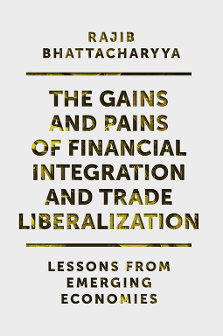
Index
The Gains and Pains of Financial Integration and Trade Liberalization
ISBN: 978-1-83867-004-7, eISBN: 978-1-78973-999-2
Publication date: 26 November 2019
Citation
(2019), "Index", Bhattacharyya, R. (Ed.) The Gains and Pains of Financial Integration and Trade Liberalization, Emerald Publishing Limited, Leeds, pp. 267-272. https://doi.org/10.1108/978-1-78973-999-220191030
Publisher
:Emerald Publishing Limited
Copyright © 2020 by Emerald Publishing Limited
INDEX
- Prelims
- Introduction
- Chapter 1 How Do Trade Openness and Financial Integration Affect Growth and Output Volatility?
- Chapter 2 Globalization, Financial Integration, and Growth: Any Linkage So Far for Brazil, China, and India?
- Chapter 3 A Latent Variable Modeling of a Multidimensional Index of Economic and Financial Integration of Australia with the Arab and Southeast Asian Emerging Economies
- Chapter 4 Understanding Characteristics of Economic Growth in the Emerging Economies during the Post-financial Liberalization Period: Case Study of India and Brazil
- Chapter 5 Trade Openness, Financial Openness, and Growth in Emerging Market Economies: A Dynamic Panel Approach
- Chapter 6 FDI, Trade, and Economic Growth: A Dynamic Panel Study on Global Economy
- Chapter 7 Joint Estimation of Fiscal Policy, Income Inequality, Trade and Economic Growth: Evidence from Emerging Market Economy
- Chapter 8 Digital Financial Integration, Investment, Economic Growth, Development and Poverty Reduction
- Chapter 9 A New Look at the Dynamics of India's Balance of Payments through Its Liberalization Episode
- Chapter 10 Impact of Risk Perceptions on Foreign Direct Investment (FDI) Inflows: A Study of Emerging Economies
- Chapter 11 Financial Development and Financial Market Integration in India: A Post-reform Scenario
- Chapter 12 Trends in Financial Integration and Financial Development in Selected Asian Countries: Is There Any Relationship?
- Chapter 13 Co-movement and Co-integration: A Study on Nifty, Dow Jones, and N225
- Chapter 14 Imported Inflation through Exchange Rate in India
- Chapter 15 Looking Back at Capital Account Convertibility: India–China Syndrome
- Chapter 16 Financial Integration, Its Implication for Money Laundering – An Introspection
- Chapter 17 Economic Partnership Agreement between Mexico and Japan and Its Impact on Foreign Direct Investment – A Strategic Analysis
- Chapter 18 A Survey of Research Studies on Measurement of Financial Integration
- Chapter 19 India's Export Opportunities in the ASEAN Market
- Chapter 20 A Study on the Effect of Liberalization and Trade Integration on the Vietnamese Economy and Its Comparative Analysis with that of India
- Index